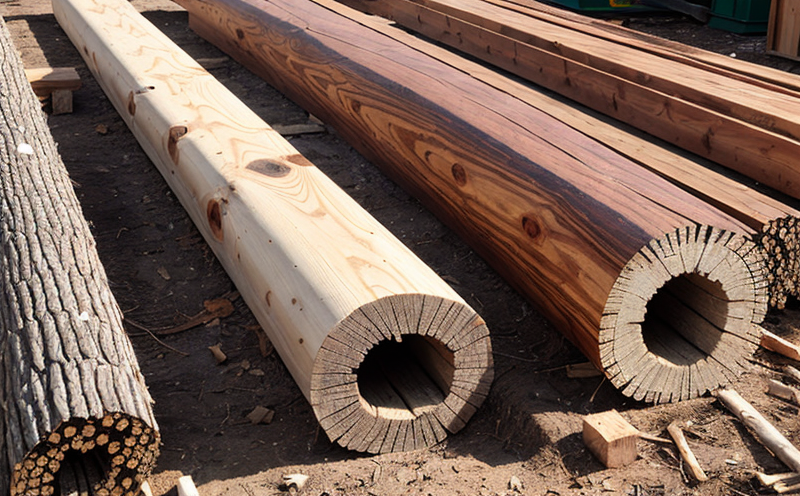Accelerated Laboratory Decay Test for Wood Samples
The accelerated laboratory decay test is a critical tool in the agriculture and forestry sector to assess the durability and preservation properties of wood materials. This testing method simulates natural decay processes, providing insights into how different preservatives, treatments, or environmental conditions affect wood longevity.
During this process, wood specimens are exposed to controlled environments that mimic the conditions under which biological decay occurs in nature but at an accelerated rate. The primary goal is to predict the service life of treated wood products before they are subjected to real-world use. This ensures that timber products used in construction, marine applications, and other sectors can withstand the challenges posed by environmental factors such as humidity, temperature changes, and microbial activity.
The accelerated decay test involves several key steps: sample preparation, incubation under controlled conditions, observation of degradation, and final analysis. Samples are carefully selected based on their intended use, size, and species composition. After preparation, these samples undergo exposure to a combination of moisture, temperature, and microbial agents that promote rapid deterioration.
The test typically follows ISO standards such as ISO 11401 or ASTM D2397, which provide detailed protocols for specimen selection, testing procedures, and evaluation criteria. These international guidelines ensure consistency across different laboratories worldwide, making the results universally applicable. By adhering to these specifications, we guarantee accurate and reliable data that can be trusted by industry stakeholders.
One of the main advantages of this accelerated laboratory decay test is its ability to provide quick insights into potential issues before large-scale investments are made in production or construction projects. It helps manufacturers optimize their treatment processes, select appropriate preservatives, and develop more resilient products tailored specifically for various applications within the agricultural and forestry sectors.
Moreover, this testing method allows researchers to study long-term effects of different treatments on wood durability without waiting years for natural decay to occur. This accelerated approach not only saves time but also accelerates innovation by enabling rapid iteration cycles during product development stages.
In summary, the accelerated laboratory decay test plays an essential role in ensuring high-quality, sustainable timber products across various industries within agriculture and forestry. By leveraging this technology, companies can enhance product performance while minimizing environmental impact through informed decision-making processes rooted in scientific evidence rather than guesswork.
Benefits
The accelerated laboratory decay test offers numerous benefits that make it indispensable for quality managers, compliance officers, R&D engineers, and procurement professionals alike. Firstly, it provides a cost-effective way to evaluate the effectiveness of different preservative treatments on wood samples before full-scale implementation. This saves both time and resources by allowing companies to identify optimal solutions early in the design phase.
Secondly, this testing method enables manufacturers to ensure compliance with regulatory requirements related to product safety and environmental protection. By demonstrating adherence to relevant standards like ISO 11401 or ASTM D2397, businesses can build credibility among customers who demand eco-friendly materials without compromising functionality.
Additionally, the accelerated decay test supports sustainable practices by promoting resource efficiency throughout the supply chain. Through precise testing, companies can minimize waste and reduce energy consumption associated with unnecessary trials of failed products or treatments.
For R&D engineers, this tool serves as a valuable asset in exploring new possibilities for wood preservation technologies. The ability to observe rapid changes allows researchers to refine existing methods or discover entirely novel approaches that could revolutionize the field.
In terms of customer satisfaction, offering reliable and durable wood products enhances reputation and trustworthiness among end-users. When customers know their investments are backed by robust testing procedures, they feel more secure about purchasing from reputable sources.
Why Choose This Test
Selecting the right testing method is crucial when dealing with wood durability and preservation issues. The accelerated laboratory decay test stands out due to its unique combination of speed, accuracy, and relevance to real-world scenarios. Unlike field trials that may take months or even years to produce results, this lab-based approach accelerates the process significantly while maintaining scientific rigor.
One significant advantage is the controlled environment offered by this testing method. By carefully selecting and manipulating variables like temperature, humidity, and microbial load, researchers can precisely mimic specific environmental conditions that influence wood decay rates. This level of control ensures consistent results that are directly comparable across different studies or product comparisons.
Another compelling reason to choose the accelerated laboratory decay test lies in its ability to identify potential weaknesses early on during development stages. Early detection allows manufacturers to address any issues promptly, reducing costs associated with recalls or redesigns later down the line.
The test also supports continuous improvement efforts by providing ongoing feedback about the performance of various treatments over time. As new materials and methods emerge, regular testing helps stay ahead of trends and adapt to changing market demands more effectively.
Customer Impact and Satisfaction
Implementing an accelerated laboratory decay test has a direct positive impact on customers by delivering superior quality products that meet or exceed expectations. When companies invest in this type of testing, they demonstrate their commitment to excellence and customer satisfaction. Customers appreciate the confidence instilled by seeing rigorous evaluation processes at work behind the scenes.
For end-users who rely heavily on wood-based materials for structural integrity or aesthetic appeal, knowing that these products have undergone thorough testing reassures them about longevity and reliability. This perception translates into increased loyalty towards brands known for quality assurance practices like accelerated laboratory decay tests.
The test results also contribute to enhanced regulatory compliance which is increasingly important in today’s competitive markets where environmental concerns play a significant role. By ensuring that all products meet stringent criteria set forth by relevant bodies, companies can avoid costly penalties and maintain favorable public images.





